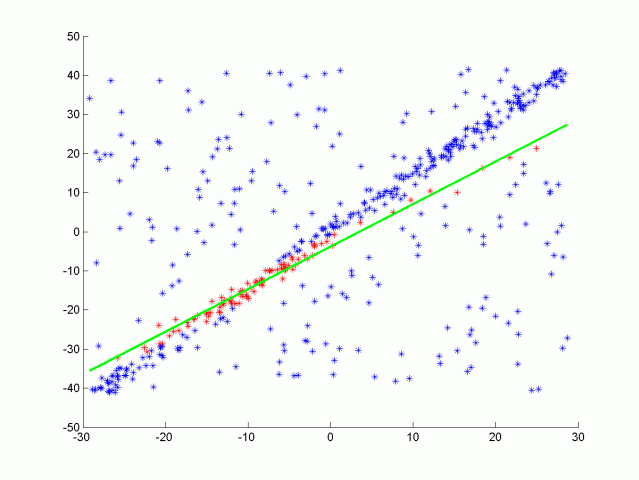Lidar系列文章
传感器融合是将多个传感器采集的数据进行融合处理,以更好感知周围环境;这里首先介绍激光雷达的相关内容,包括激光雷达基本介绍(本节内容),激光点云数据处理方法(点云数据显示,点云分割,点云聚类,障碍物识别实例)等。
系列文章目录
1. 激光雷达基本介绍
2. 激光点云数据显示
3. 基于RANSAC的激光点云分割
4. 点云分割入门级实例学习
5. 激光点云目标物聚类
6. 基于PCL实现欧式聚类提取
7. 激光雷达障碍物识别
RANSAC随机抽样一致简介
RANSAC(RANdom SAmple Consensus)随机抽样一致,最早于1981年由Fischler和Bolles提出,基本思想是根据一组包含噪声、外点的各种缺陷的样本数据集中,估计出数据的数学模型参数,并同时得到有效样本数据。
RANSAC从一组包含“局外点”的观测数据集中,通过迭代方式估计数学模型的参数。每次迭代时选取一个数据子集(线:2个数据点,面:三个数据点)并对其进行拟合,计算剩余点到拟合后的模型(线/面)的距离,包含最多数量的“局内点”(距离模型一定范围内的点)或最小的噪声作为最佳模型。

类似的RANSAC方法也包括先对数据集进行采样(如20%数据),对其进行拟合并计算偏差,偏差最小的为最佳模型。这种方法的优势是每次迭代中不用考虑所有点。
实例-使用RANSAC拟合直线
对于平面中的点,RANSAC方法拟合直线的主要步骤如下:
- 每次迭代中从数据集中随机采样2个点;
- 基于两个采样点拟合一条直线;
- 计算每个点到拟合直线的距离,容差内的点为内点。
- 每次迭代过程中跟踪拟合的直线,保留内点最多的拟合直线,即为最佳的模型。
下面将以RANSAC拟合2D点云中的直线进行介绍。下图是对数据集进行采样的子集。

直线公式:
A x + B y + C = 0 Ax+By+C=0 Ax+By+C=0
设其经过点1(x1, y1)和点2(x2, y2),则经过这两点的直线公式为:
( y 1 − y 2 ) x + ( x 2 − x 1 ) y + ( x 1 ∗ y 2 − x 2 ∗ y 1 ) = 0 (y1−y2)x+(x2−x1)y+(x1∗y2−x2∗y1)=0 (y1−y2)x+(x2−x1)y+(x1∗y2−x2∗y1)=0
平面内点(x,y)到直线的距离d:
d = ∣ A x + B y + C ∣ / s q r t ( A 2 + B 2 ) d=∣Ax+By+C∣/sqrt(A^2 +B^2 ) d=∣Ax+By+C∣/sqrt(A2+B2)
std::unordered_set<int> Ransac(pcl::PointCloud<pcl::PointXYZ>::Ptr cloud, int maxIterations, float distanceTol)
{
std::unordered_set<int> inliersResult;
srand(time(NULL)); //srand() generate a random seed associate with current time.
// TODO: Fill in this function
// For max iterations
// Randomly sample subset and fit line
// Measure distance between every point and fitted line
// If distance is smaller than threshold count it as inlier
// Return indicies of inliers from fitted line with most inliers
// Time segmentation process
auto startTime = std::chrono::steady_clock::now();
while(maxIterations--)// For max iterations
{
//Randomly pick two points;
std::unordered_set<int> inliers;
while(inliers.size()<2)
inliers.insert(rand()%(cloud->points.size()));
float x1, y1, x2, y2;
auto itr = inliers.begin();
x1 = cloud->points[*itr].x;
y1 = cloud->points[*itr].y;
itr++;
x2 = cloud->points[*itr].x;
y2 = cloud->points[*itr].y;
//Line formula ax + by + c = 0
float a = y1 - y2;
float b = x2 - x1;
float c = x1*y2 - x2*y1;
// Measure distance between every point and fitted line
// If distance is smaller than threshold count it as inlier
for(int index=0; index < cloud->points.size(); index++)
{
//discard previous two points
if(inliers.count(index)>0)
continue;
pcl::PointXYZ point = cloud->points[index];
float x3 = point.x;
float y3 







 最低0.47元/天 解锁文章
最低0.47元/天 解锁文章














 549
549











 被折叠的 条评论
为什么被折叠?
被折叠的 条评论
为什么被折叠?








